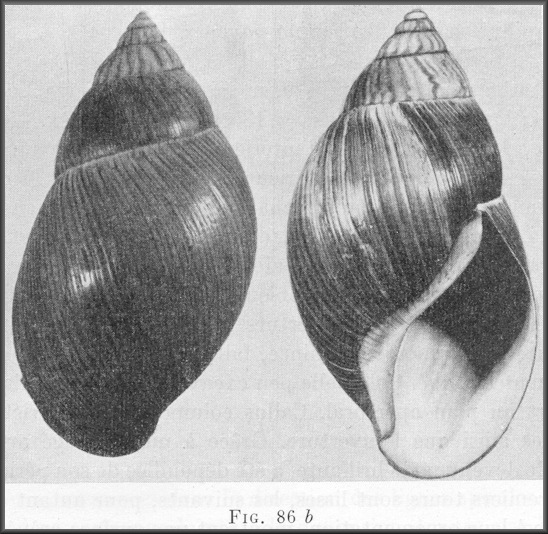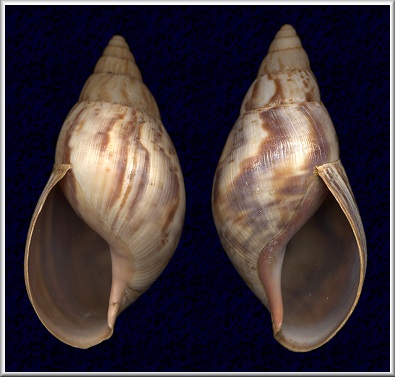Lamarck (1822: 128
<http://www.biodiversitylibrary.org/item/26549#page/486/mode/1up>)
introduced the binomen Achatina immaculata. The description
is rather general and the figure references ambiguous, but the "columella
roseo tincta" led some authorities to tie it to A. panthera,
a name made available by Férussac a decade later. After over a
century had passed, the achatinid authority Joe Bequaert considered
the Lamarck taxon inadequately defined, that is, a nomen dubium,
and thus did not employ it as a valid name for the species in
question (Bequaert, 1950: 100 <http://www.biodiversitylibrary.org/item/43478#page/102/mode/1up>)
However, a mere fifteen months later, Mermod (1952: 740-742)
discovered a specimen that almost certainly was in Lamarck's type
series, illustrated it (Idem: fig. 86b [see
image below]),
and further remarked that it was the shell illustrated by
Férussac (1823: pl. 127, figs. 1, 2) and
later captioned and described as "Achatina immaculata
Lamarck" (Férussac, 1832?: Tome 2: 158), matched it in size
and idiosyncratic conchological detail (the atypical growth rest one
whorl before the aperture).

Thus most modern workers have followed Mermod's interpretation of
the species and concede availability, thus seniority and validity,
to the Lamarckian name.
Bequaert, J.C., 1950. Studies in the Achatininae, a group of African
land snails. Bulletin of the Museum of Comparative Zoology 105(1):1-215
+ pls. 1-81. Sep.
<http://www.biodiversitylibrary.org/item/43478#page/3/mode/1up>.
Férussac [A.E.J.P.J.F. d’A.], Baron de, 1821. Tableaux
systématiques des animaux mollusques classés en familles naturelles,
dans lesquels on a établi la concordance de tous les systèmes;
suivis d’un prodrome général pour tous les mollusques terrestres ou
fluviatiles, vivants ou fossils. [Premiere Partie Tableaux
systématiques généraux de l’embranchemant divisés en familles
naturelles] Deuxième partie (premiere section.). Tableaux
particuliers des mollusques terrestres et fluviatiles, présentant
pour chaque famille les genres et espèces qui la composent.
Bertrand, Paris. [i]-xlvii + [i] + [3]-27 + [3]-110 + [i].
<http://www.biodiversitylibrary.org/item/41533#page/9/mode/1up>
This monograph forms a part of the author's larger work, Férussac
and Deshayes, 1819-1851; vide infra, which is a
bibliographer's worst nightmare.
1,2 Férussac, A.E.J. P.J. F d'A. de and G.-P. Deshayes,
1819-1851. Histoire naturelle générale et particulière des
mollusques terrestres et fluviatiles, tant des espèces que l'on
trouve aujourd'hui vivantes, que des dépouilles fossiles de celles
qui n'existent plus; classés d'après les caractères essentiels que
présentent ces animaux et leurs coquilles. J.-B. Bailliere,
Paris. Tome 1: 8 + 184 pp; Tome 2 (1): 402 p.; Tome
2 (2): 260 + 22 + 16 pp; 3Atlas 1 (Tome 3):
pls. 1- 70; 4Atlas 2 (Tome 4): pls. 71-166 + pls.
1-5.
Lamarck, J. B. P. A. de M. de, 1822. Histoire naturelle des
animaux sans vertèbres présentant les caractères généraux et
particuliers de ces animaux, leur distribution, leurs classes, leur
familles, leurs genres, et la citation des principales espèces qui
s'y rapportent; précédée d'une introduction offrant la détermination
des caractères essentiels de l'animal, sa distinction du végétal et
des autres corps naturels; enfin l'exposition des principes
fondamentaux de la zoologie. [Première édition] Tome 6 Partie 1.
Lamarck, Paris. i-vi + 1-232. April. <http://www.biodiversitylibrary.org/item/26549#page/357/mode/1up>
Mermod, G., 1951. Les types de la collection Lamarck au Muséum de
Genève.mollusques vivantes, III. Revue Suisse de Zoologie 59(2):
(1)-97. March.
Footnotes:
1This work appeared in many livraisons/Lieferungen. In
the period 1819-1832, 28 livraisons appeared, consisting of texts
and plates, not necessarily connected with each other. Many plate
numbers appeared twice. Covers usually had no important texts or
names printed on them. Explanations of plates 1-47 were published in
livraison 9 (06 Apr., 1821), explanation of included plates on the
cover in livraison 17 (2 Nov., 1822), explanation of plates on the
cover of livraisons 22-27 (4 Aug., 1832 - serious error in Bouchet &
Rocroi 2005: 305: "4 August 1823" is a misprint for "4 August 1832")
(species were printed in small caps in these lists, with references
to corresponding numbers in Prodr. [italics]). When the whole
work was finished, a final issue of plate explanations appeared
(1851, species names were in normal and bold font, authors not bold,
no references to Prodr.). Usually only the final plate
explanations were bound, while the initial plate explanations,
different from the final ones, were not conserved by librarians.
Title, préface pp (i)-xvi (6 Mar., 1819)
pp pp 1-16 (5 Jun., 1819)
pp 17-56 (10 Jul., 1819)
pp 57-72 (18 Sep., 1819)
pp 73-96 (4 Dec., 1819)
pp 97-128 (17 Jun., 1820)
explanation of plates 1-47 (6 Apr 1821)
explanation of plates 48, 53, 63, 75A, 75B, 113 (2 Nov., 1822)
pp 96a-96[lambda] (27 Sep., 1823)
explanation of plates of livraisons 22-27 (many plates, 4 Aug. 1832)
explanation of plates 8E, 126, 131B, 133, 141, 147 (4 Aug., 1832 ?)
(cover not conserved in London but should have existed)
Plates (uncaptioned): 1, 2, 4, 8, 12 (6 Mar., 1819); 3, 5-7, 11, 13
(5 Jun., 1819); 9, 15-17, 19, 23 (18 Sept., 1819); 14, 18, 20, 22,
24, 25 (4 Dec., 1819); 21, 21A, 26-28, 30 (26 Feb., 1820); 29,
30-34, 57 (17 June, 1820); 52, 75, "66"[=76], 91, 92, 103 (5 Aug.,
1820); 8A, 39A, 54, 73, 112, 120 (6 Apr., 1821); 32B, "101"[=51B],
63A,114, 115, 159 (26 May, 1821); 11A, 21B, 32A, 35, 39, 44 (13
July, 1821); 36, 38, 46, 81, 108, 118 (21 Sept., 1821); 9A, 37, 40,
41, 43, 62 (10 Nov., 1821); the others by Férussac in 1822 and 1823.
Plates issued by Deshayes:
pl. 8F,
10A, 17A, 28A, 29A,
69C,
73B, 83, 84, 106, 107, 129 (1839)
pl. 10B, 62A, 69B, 69D-69H, 69K, 72, 85, 86 (1840)
pl. 37A, 55 [4], 62B, 64A, 69I, 69J,
75C,
87, 89 [2], 90 [3], 127A, 127B (1841).
Many new taxa were not listed by Sherborn 1922. Sherborn listed the
taxa mentioned by Férussac (1821), and marked them as "n[omina].
n[uda],"
but he overlooked the fact that most taxa were
made
available
by Férussac later, dating from 1832 when the plate explanations
appeared.
The
above
collation
is
based on Bouchet and Rocroi (2005: 304), Kennard (1942:1-4), and
Gittenberger and Groh (1986).
<http://www.animalbase.uni-goettingen.de/zooweb/servlet/AnimalBase/home/reference?id=145>.
2There is a curious text version of the above work at
<http://books.google.com/books?id=6hBQAAAAcAAJ&pg=RA1-PA162&lpg=RA1-PA162&dq=Achatina+%22Histoire+naturelle+g%C3%A9n%C3%A9rale+et+particuli%C3%A8re+des+mollusques+terrestres+et+fluviatiles%22&source=bl&ots=aqQTairPi7&sig=2Ye8n-BrB0uIkJbqN7CW8ORvNA4&hl=en&sa=X&ei=XqKuT-3dIIjc9ASH2rnhCA&ved=0CFgQ6AEwAA#v=onepage&q&f=false>.
It has an 1819 title page and is comprised of "Tome I"
beginning with a préface [pp (i)-xvi] followed by (1)-184, but
having are many, many pages no. 96 (various sub-pagination
indicators, e.g. 96a, 96b, etc.) and "Tome II," which runs from (1)
to p. 260.
3Atlas 1 (Tome 3) with plates 1-69K (69, 69A, etc.
yielding 12 pl. 69's and lots of other A's and B's; plate 70
missing, perhaps missed in the scanning process) is posted at
<http://books.google.com/books/about/Histoire_naturelle_g%C3%A9n%C3%A9rale_et_particu.html?id=8hBQAAAAcAAJ>.
4Atlas 2 (Tome 4) is posted at
<http://books.google.com/books?id=JolDAAAAcAAJ&printsec=frontcover&source=gbs_ge_summary_r&cad=0#v=onepage&q&f=false>
and contains plates 71 to 166 [with multiple A's and B's] + fossil
plates 1 to 5 + (1)-22 [explication des planches; cross-referenced
to indicate that there are 247 plates in toto] + ii, unpaginated
[errata and addenda].
Atlas 1 and 2 are comprised of extremely well-executed
prints. |

